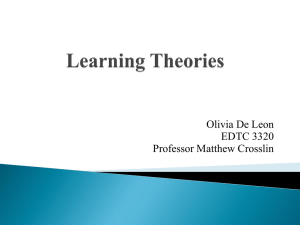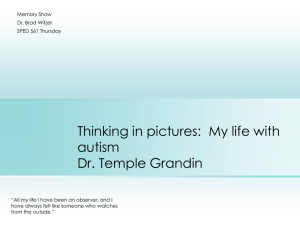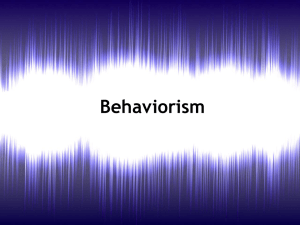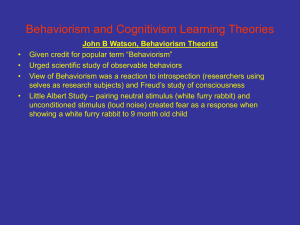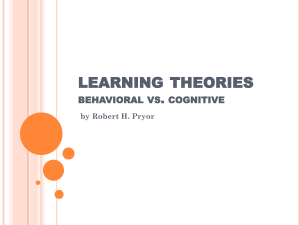Learning Sequence
advertisement
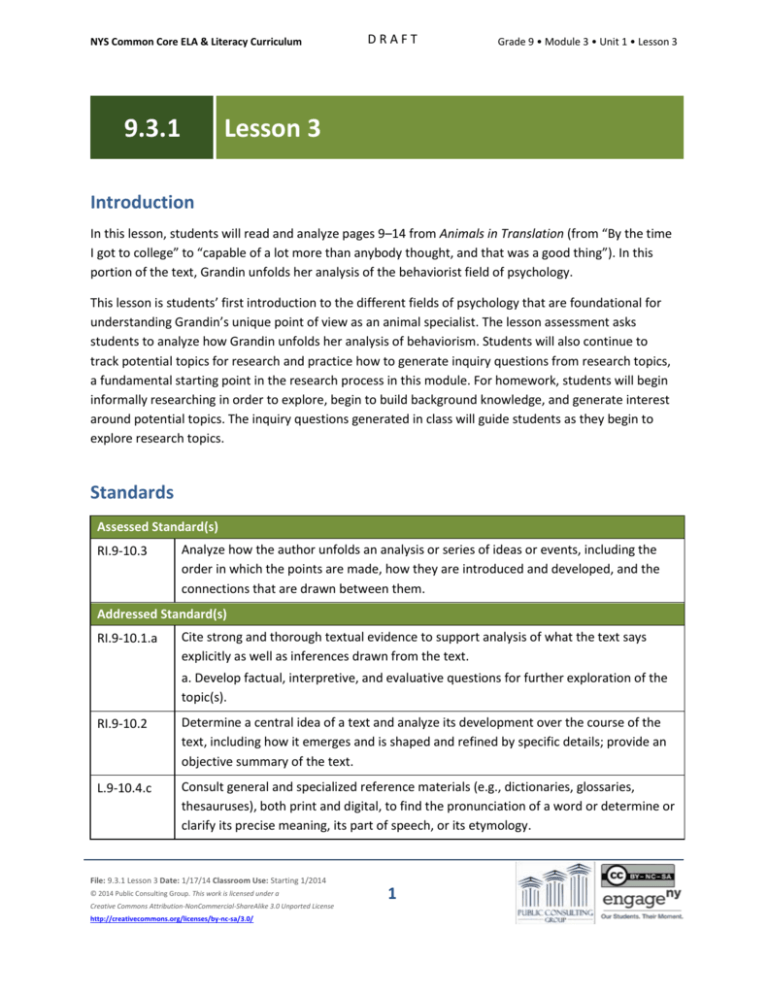
NYS Common Core ELA & Literacy Curriculum 9.3.1 DRAFT Grade 9 • Module 3 • Unit 1 • Lesson 3 Lesson 3 Introduction In this lesson, students will read and analyze pages 9–14 from Animals in Translation (from “By the time I got to college” to “capable of a lot more than anybody thought, and that was a good thing”). In this portion of the text, Grandin unfolds her analysis of the behaviorist field of psychology. This lesson is students’ first introduction to the different fields of psychology that are foundational for understanding Grandin’s unique point of view as an animal specialist. The lesson assessment asks students to analyze how Grandin unfolds her analysis of behaviorism. Students will also continue to track potential topics for research and practice how to generate inquiry questions from research topics, a fundamental starting point in the research process in this module. For homework, students will begin informally researching in order to explore, begin to build background knowledge, and generate interest around potential topics. The inquiry questions generated in class will guide students as they begin to explore research topics. Standards Assessed Standard(s) RI.9-10.3 Analyze how the author unfolds an analysis or series of ideas or events, including the order in which the points are made, how they are introduced and developed, and the connections that are drawn between them. Addressed Standard(s) RI.9-10.1.a Cite strong and thorough textual evidence to support analysis of what the text says explicitly as well as inferences drawn from the text. a. Develop factual, interpretive, and evaluative questions for further exploration of the topic(s). RI.9-10.2 Determine a central idea of a text and analyze its development over the course of the text, including how it emerges and is shaped and refined by specific details; provide an objective summary of the text. L.9-10.4.c Consult general and specialized reference materials (e.g., dictionaries, glossaries, thesauruses), both print and digital, to find the pronunciation of a word or determine or clarify its precise meaning, its part of speech, or its etymology. File: 9.3.1 Lesson 3 Date: 1/17/14 Classroom Use: Starting 1/2014 © 2014 Public Consulting Group. This work is licensed under a Creative Commons Attribution-NonCommercial-ShareAlike 3.0 Unported License http://creativecommons.org/licenses/by-nc-sa/3.0/ 1 NYS Common Core ELA & Literacy Curriculum DRAFT Grade 9 • Module 3 • Unit 1 • Lesson 3 Assessment Assessment(s) The learning in this lesson will be captured through a Quick Write at the end of the lesson. Students will answer the following prompt based on the close reading (citing text evidence and analyzing key words and phrases) completed in the lesson. How does Grandin introduce and develop her analysis of behaviorism? What connections does she make between her perspective and her analysis of behaviorism? This assessment will be evaluated using the Short Response Rubric. High Performance Response(s) A high performance response may include the following: Grandin introduces behaviorism as a popular field of psychology when she started university, “the whole field of psychology was B.F. Skinner and behaviorism” (p. 9). Behaviorists believed that since you can “measure only behavior” environment is the “only thing that mattered” (p. 9). Behaviorists also study the effect of positive and negative reinforcements to shape or modify behaviors, “punishing a bad behavior isn’t as effective as rewarding a good behavior” (p. 9). Grandin understands that there are benefits to behaviorism and the study of environment but she also believes, “Behaviorists made a big mistake declaring the brain off-limits” (p. 11). Grandin came to this conclusion through her own experiences and perspective: “I didn’t believe it because I had problems that sure didn’t seem to be coming from my environment” (p. 11). Vocabulary Vocabulary to provide directly (will not include extended instruction) behaviorism (n.) – the theory or doctrine that human or animal psychology can be accurately studied only through the examination and analysis of objectively observable and quantifiable behavioral events, in contrast with subjective mental states ethology (n.) – the study of animal behavior with emphasis on the behavioral patterns that occur in natural environments operant conditioning (n.) – the process of behavior modification that changes a subject’s behavior based on positive and negative reinforcements media specialist (n.) – In schools, the term covers a broad spectrum of educational roles. It can mean the person who operates audio-visual equipment, the librarian, a teacher with broad knowledge of media resources and the communication process, or one who helps other teachers or students locate an array of resources. File: 9.3.1 Lesson 3 Date: 1/17/14 Classroom Use: Starting 1/2014 © 2014 Public Consulting Group. This work is licensed under a Creative Commons Attribution-NonCommercial-ShareAlike 3.0 Unported License http://creativecommons.org/licenses/by-nc-sa/3.0/ 2 NYS Common Core ELA & Literacy Curriculum DRAFT Grade 9 • Module 3 • Unit 1 • Lesson 3 Vocabulary to teach (may include direct word work and/or questions) stimulus (n.) – something that causes or quickens action Lesson Agenda/Overview Student-Facing Agenda % of Lesson Standards & Text: Standards: RI.9-10.3, RI.9-10.1.a, RI.9-10.2, L.9-10.4.c Text: Animals in Translation, Chapter 1, pages 9–14 Learning Sequence: 1. 2. 3. 4. 5. 6. 1. 2. 3. 4. 5. 6. Introduction Lesson Agenda Homework Accountability Pages 9–14 Reading and Discussion Posing Inquiry Questions Quick Write Closing 5% 15% 40% 25% 10% 5% Materials Student copies of the Topic Tracking Tool (refer to 9.3.1 Lesson 2) Copies of the Posing Inquiry Questions Handout for each student Student copies of the Short Response Rubric and Short Response Checklist (refer to 9.3.1 Lesson 1) Learning Sequence How to Use the Learning Sequence Symbol Type of Text & Interpretation of the Symbol 10% no symbol Percentage indicates the percentage of lesson time each activity should take. Plain text indicates teacher action. Bold text indicates questions for the teacher to ask students. Italicized text indicates a vocabulary word. Indicates student action(s). Indicates possible student response(s) to teacher questions. Indicates instructional notes for the teacher. File: 9.3.1 Lesson 3 Date: 1/17/14 Classroom Use: Starting 1/2014 © 2014 Public Consulting Group. This work is licensed under a Creative Commons Attribution-NonCommercial-ShareAlike 3.0 Unported License http://creativecommons.org/licenses/by-nc-sa/3.0/ 3 NYS Common Core ELA & Literacy Curriculum DRAFT Grade 9 • Module 3 • Unit 1 • Lesson 3 Activity 1: Introduction of Lesson Agenda 5% Begin by reviewing the agenda and the assessed standard for this lesson: RI.9-10.3. Inform students that they will be examining how Grandin unfolds her analysis of behaviorism in this chapter as well as tracking topics and learning how to generate inquiry questions. Students look at the lesson agenda. Activity 2: Homework Accountability 15% Instruct students to Turn-and-Talk with a classmate about the definitions of behaviorism and ethology they found for homework. Differentiation Consideration: Consider reminding students these are difficult concepts and knowing the definition of these terms will help them understand the text. This is why, in addition to common online reference materials, students were encouraged to use audio and video to help gain an understanding of these terms. Explain to students that it is also helpful to put these definitions in their own words to make sure they fully comprehend the definition. Differentiation Consideration: Consider leading a brief whole-class discussion in order to clarify the meaning of behaviorism and ethology before students talk in pairs. Students Turn-and-Talk with a classmate, discussing the definitions they found for homework. Student responses should include: o o Behaviorism is the theory that human or animal psychology can be accurately studied and measured in a laboratory. Ethology is the study of animal behavior in the animal’s natural environment. Ask students: How did the resources you found help you understand these terms? Remind students that additional resources such as video clips that reinforce understanding of an idea or concept will be part of their Module Performance Assessment. It is important that students have an understanding of behaviorism as well as ethology as they continue to read Animals in Translation and it may be necessary to check in with student pairs or the entire class to confirm their understanding. Student pairs discuss the resources they found and how it helped them understand behaviorism and ethology. Student responses will vary depending on the resource: File: 9.3.1 Lesson 3 Date: 1/17/14 Classroom Use: Starting 1/2014 © 2014 Public Consulting Group. This work is licensed under a Creative Commons Attribution-NonCommercial-ShareAlike 3.0 Unported License http://creativecommons.org/licenses/by-nc-sa/3.0/ 4 NYS Common Core ELA & Literacy Curriculum o o o DRAFT Grade 9 • Module 3 • Unit 1 • Lesson 3 This entry on dictionary.reference.com helped me understand ethology because it mentions that ethology emphasizes behavior that happens in natural environments. http://dictionary.reference.com/browse/ethology?s=t This video, “Behaviorism 101, by user Nessy Mond,” helped me understand behaviorism because it presented information in a clear way and used visuals effectively. The video “Animal Behavior” by Bozeman Science helped me understand that ethology studies a wide variety of animal behaviors in their natural environments. This video used a lot of pictures and helpful examples. “Behaviorism 101” found on YouTube (http://www.youtube.com/watch?v=RU0zEGWp56Y&feature=youtu.be): © Copyright Vanessa Monaghan/Claire Whitehead/Catherine Lonegan/Ciara McDonnell. “Animal Behavior” found on YouTube (http://youtu.be/6hREwakXmAo) Creative Commons Attribution License. Activity 3: Pages 9–14 Reading and Discussion 40% Introduce and display the Quick Write assessment (How does Grandin introduce and develop her analysis of behaviorism? What connections does she make between her perspective and her analysis of behaviorism?) Students read the Quick Write assessment. Instruct students to take out their Topic Tracking Tool introduced in the previous lesson. Inform students that they will continue to record potential topics for research as they read and discuss this portion of Animals in Translation. Explain to students that they will discuss potential topics for research with a partner as they emerge from the text. Remind students to record the topics as well as the key details from Animals In Translation about the topic on their Topic Tracking Tool. Instruct students to form pairs and read pages 9–10 (from “By the time I got to college I knew” to “I wanted to talk to him about some of the research I had done”). Instruct students to discuss the following questions and record their answers. Potential topics can be found on the modeled Topic Tracking Tool at the end of this lesson. The topics revealed during Lessons 1 and 2's in-class work and assessments should provide a solid foundation for this work. Student pairs take out their Topic Tracking Tool, read, discuss, track topics, and record their answers to the questions. According to Grandin what is the central feature behaviorists observe when studying an animal or human psychology? File: 9.3.1 Lesson 3 Date: 1/17/14 Classroom Use: Starting 1/2014 © 2014 Public Consulting Group. This work is licensed under a Creative Commons Attribution-NonCommercial-ShareAlike 3.0 Unported License http://creativecommons.org/licenses/by-nc-sa/3.0/ 5 NYS Common Core ELA & Literacy Curriculum DRAFT Grade 9 • Module 3 • Unit 1 • Lesson 3 Grandin writes that behaviorists believe that the “environment was the only thing that mattered” (p. 9). Differentiation Consideration: Remind students that this is the reason they searched, defined, and found a resource to understand the concept of behaviorism and that sometimes authors don’t always explain complicated concepts in a text. What is the “black box” and why was it off-limits to behaviorists? It was stuff, intelligence, emotions, and motives that you could not measure. Behaviorists only look at environment because you cannot see what is happening inside a person or an animal’s head. What is the difference between punishment and negative reinforcement? Punishment is something bad happening to you and negative reinforcement is “something you don’t like either stops or doesn’t start in the first place.” Differentiation Consideration: Consider these questions to scaffold student understanding of positive and negative reinforcements: What is the effect of positive and negative reinforcements? Positive and negative reinforcements shape animal behavior. “Animals only had behavior, which was shaped by…positive and negative reinforcements from their environment.” What kind of reinforcements are the most effective? Grandin writes that “rewarding good behavior” is more effective than punishment. Based on Grandin’s explanations of different types of positive and negative reinforcements, explain in your own words what she means by “stimulus-response machines.” Behaviorists thought that animals were “stimulus-response machines” (p. 10), meaning that they would all react the same way to positive and negative reinforcements in an automatic way. What details has Grandin introduced about behaviorism in this portion of text? Give three pieces of evidence to support your answer. Grandin has introduced several details about behaviorism. First, behaviorists believe that “environment was the only thing that mattered,” (p. 9) when studying animals who they think do not “have emotions or intelligence,” (p. 9). Grandin writes that behaviorists think that since animals are totally behavior driven their behavior can be “shaped by rewards, punishments.” File: 9.3.1 Lesson 3 Date: 1/17/14 Classroom Use: Starting 1/2014 © 2014 Public Consulting Group. This work is licensed under a Creative Commons Attribution-NonCommercial-ShareAlike 3.0 Unported License http://creativecommons.org/licenses/by-nc-sa/3.0/ 6 NYS Common Core ELA & Literacy Curriculum DRAFT Grade 9 • Module 3 • Unit 1 • Lesson 3 Differentiation Consideration: Consider modeling behaviorism as a potential research topic to students who may need more support with the Topic Tracking Tool. Ask students to read pages 10–12 (from “His office called and invited me down” to “It works better because it respects the animal’s behavior”). Instruct students to discuss the following questions and record their answers. Remind students to continue to record potential research topics on their Topic Tracking Tool. Provide the definition of operant conditioning as: the process of behavior modification that changes a subject’s behavior based on “positive and negative reinforcements from their environment,” (p. 9). Student pairs read, discuss, track topics, and record their answers to the questions. Why did Dr. Skinner believe that operant conditioning made the study of the brain unnecessary? Skinner believed that studying the effect of positive and negative reinforcements on behavior was such a powerful way to understand animal and human thinking that studying the brain did not seem necessary. “Animals only had behavior, which was shaped by rewards, punishments, and positive and negative reinforcements from the environment” (p. 9). What made Grandin believe that Dr. Skinner’s claim that operant conditioning was wrong? Give evidence to support your answer. From her own experience Grandin saw that she “had problems that sure didn’t seem to be coming from my environment.” In addition, in her ethology class she studied how instincts are “hardwired” into the animal without any influence from the environment. What is the connection between behaviorists and ethologists? What does Grandin think about their approach to studying animals? Behaviorists and ethologists both study animals in their environments. Behaviorists study animals in laboratories while ethologists study them in their natural environments. Grandin, however, thinks that “looking at animals [only] from the outside” and “declaring the brain offlimits” (p. 11) is a big mistake. How does Grandin support her claim that “the equipment won’t work if the environment is bad”? How does this claim relate to behaviorism? Grandin supports this claim through her experience with designing equipment in the meatpacking industry, comparing the inefficient old V-restrainers with her new design: “animals don’t like to walk into a space where they feel like there isn’t enough space for their feet” File: 9.3.1 Lesson 3 Date: 1/17/14 Classroom Use: Starting 1/2014 © 2014 Public Consulting Group. This work is licensed under a Creative Commons Attribution-NonCommercial-ShareAlike 3.0 Unported License http://creativecommons.org/licenses/by-nc-sa/3.0/ 7 NYS Common Core ELA & Literacy Curriculum DRAFT Grade 9 • Module 3 • Unit 1 • Lesson 3 (p. 12). She also says “a lot of plant owners don’t think twice about their cattle’s environment” (p. 12). Her innovation in the industry is a result of examining the cattle’s environment as well as viewing the environment from their perspective. Why does Grandin claim she is not an “enemy of behaviorism”? Grandin makes this claim because she uses behaviorism a lot in her work with animals, “My design innovation wasn’t technological, it was behavioral.” She uses behaviorism to support her understanding of animals but doesn’t believe “the laws of learning were simple and universal, and all creatures followed them” (p. 12). How does Grandin develop her analysis of behaviorism in this portion of text? Grandin writes that she did not agree with Dr. Skinner’s statement that operant conditioning was the only thing that needed to be studied to understand the psychology of an animal. Grandin disproves Dr. Skinner’s claim using her knowledge of ethology as well as her own experience, “I had problems that sure didn’t seem to be coming from my environment” (p. 11). Grandin also introduces positive aspects of behaviorism, making her analysis more complex. She writes that behaviorist’s focus on the study of the environment “was a huge step forward” (p. 11) toward understanding animal behavior. Ask students to read pages 12–14 (from “But the plants don’t realize that” to “capable of a lot more than anybody thought, and that was a good thing”). Instruct students to discuss the following questions and record their answers. Remind students to continue to record potential research topics on their Topic Tracking Tool. What was the significance of Dr. Lovaas’s study? How does the inclusion of this study further develop Grandin’s analysis of behaviorism? Dr. Lovaas’s study was important because it gave “a reason to think that autistic people were capable of a lot more than anybody thought” (pp. 13–14). This study develops Grandin’s positive analysis of behaviorism, its benefits, and successes even if she does not fully agree with all behaviorist ideas. Activity 4: Posing Inquiry Questions 25% Instruct students to keep out their Topic Tracking Tool. Inform students that they will continue to record topics, the same way they were introduced to in the previous lesson, and that today they will begin to use these topics to generate inquiry questions to deepen their understanding. Explain to students that during this research process they will be using inquiry questions to guide their research and analysis. File: 9.3.1 Lesson 3 Date: 1/17/14 Classroom Use: Starting 1/2014 © 2014 Public Consulting Group. This work is licensed under a Creative Commons Attribution-NonCommercial-ShareAlike 3.0 Unported License http://creativecommons.org/licenses/by-nc-sa/3.0/ 8 NYS Common Core ELA & Literacy Curriculum DRAFT Grade 9 • Module 3 • Unit 1 • Lesson 3 This process is recurring and they will continue to surface new questions as they acquire information about their research topics. Students listen. Inform students that Animals in Translation will be used to generate sample topics for research in this module. Explain that Temple Grandin touches on many topics throughout the first chapter of Animals in Translation. Of these, they will use autism as a sample topic to generate inquiry questions as a class. Distribute the Posing Inquiry Questions Handout to students. Inform students that they will be focusing on generating inquiry questions that they will select and refine in later lessons. At this stage, the inquiry questions are meant to guide an initial exploration of a topic. Instruct students to read the Generating Questions portion of the handout. Students read the Generating Questions portion of the handout. Explain to students that by using the questions on the handout concerning each individual topic, it is possible to come up with a wide variety of inquiry questions. Remind students to consider what they find interesting and what they would like to know more about when they are generating questions. Explain to students at this stage it is best to brainstorm as many questions as possible. Students listen. Display the autism topic for students and the example inquiry question: How does autism affect the human brain? Explain to students that based on the “What are its causes and implications?” prompt from the handout this is an open-ended inquiry question. Ask students to volunteer potential inquiry questions. Student responses may include: o o o o o o o o o o How is autism defined? What is the history of autism? Where did autism originate? What are the major aspects of autism? What are the characteristics of autism? Why might people with autism be able to understand animals better than people without autism? What else is autism connected and associated with? Who are famous or important autistic people? Who is an expert on autism? Are there countries that have more people with autism than others? File: 9.3.1 Lesson 3 Date: 1/17/14 Classroom Use: Starting 1/2014 © 2014 Public Consulting Group. This work is licensed under a Creative Commons Attribution-NonCommercial-ShareAlike 3.0 Unported License http://creativecommons.org/licenses/by-nc-sa/3.0/ 9 NYS Common Core ELA & Literacy Curriculum DRAFT Grade 9 • Module 3 • Unit 1 • Lesson 3 Instruct students to form pairs, choose a topic from the Topic Tracking Tool and generate five inquiry questions. Student responses will vary depending on the potential research topic. Student responses may include: Topic: Behaviorism Inquiry Questions: o What is the history of behaviorism? o Who are experts in behaviorism? o What are major aspects of behaviorism? o What are important discoveries behaviorists have found when observing animals? o What else is behaviorism associated with besides animal psychology? Activity 5: Quick Write 10% Instruct students to respond to the following Quick Write prompt: How does Grandin introduce and develop her analysis of behaviorism? What connections does she make between her perspective and her analysis of behaviorism? Display the prompt for students to see, or provide the prompt in hard copy. Remind students to use the Short Response Checklist and Short Response Rubric to guide their written responses. Students independently respond to the Quick Write prompt. See the High Performance Response at the beginning of this lesson. Activity 6: Closing 5% Display and distribute the homework assignment. For homework, instruct students to begin researching unknown topics using their inquiry questions developed in class as a guide. Remind students to consult other teachers, librarians, media specialists, books, the Internet, or any other available resource. The purpose of exploring a topic at this stage is to identify areas of interest within the topic and explore the dimensions of a topic. Instruct students to write 1–2 sentences identifying their area of interest within their research topic and come to the following lesson prepared to discuss one area of interest. File: 9.3.1 Lesson 3 Date: 1/17/14 Classroom Use: Starting 1/2014 © 2014 Public Consulting Group. This work is licensed under a Creative Commons Attribution-NonCommercial-ShareAlike 3.0 Unported License http://creativecommons.org/licenses/by-nc-sa/3.0/ 10 NYS Common Core ELA & Literacy Curriculum DRAFT Grade 9 • Module 3 • Unit 1 • Lesson 3 Explain to students that a media specialist can be the person who operates audio-visual equipment, the librarian, a teacher with broad knowledge of media resources and the communication process, or one who helps other teachers or students locate an array of resources. It may be helpful to identify ahead of time the appropriate person/people in the building who will assist students with locating resources for their research. Students follow along. Homework Use your inquiry questions to guide your research and begin exploring various dimensions of a topic. Consult other teachers, media specialists, librarians, books, the Internet, or any other available resources. Begin to identify areas of interest within your research topic. Write 1–2 sentences identifying your area of interest within your research topic and be prepared to discuss one area of interest in the following lesson. File: 9.3.1 Lesson 3 Date: 1/17/14 Classroom Use: Starting 1/2014 © 2014 Public Consulting Group. This work is licensed under a Creative Commons Attribution-NonCommercial-ShareAlike 3.0 Unported License http://creativecommons.org/licenses/by-nc-sa/3.0/ 11 DRAFT NYS Common Core ELA & Literacy Curriculum Grade 9 • Module 3 • Unit 1 • Lesson 3 Model Topic Tracking Tool Name: Class: Date: Topic Page Number(s) Key Information About the Topic from the Text behaviorism 9–14 Grandin writes that behaviorism dominated the whole field of psychology. To behaviorists “environment was the only thing that mattered.” They thought animals had no emotions only behaviors. B.F. Skinner 9–12 Dr. Skinner was, according to Grandin, “the god of psychology.” He was a very influential behaviorist thinker. ethology 11 Ethology is a field of animal psychology as well. Although the big difference from behaviorism is that, “ethologists study animals in their natural environment.” meatpacking industry 12 Grandin writes about her work in the meatpacking industry. A system she designed is being used in “half of all the plants in North America.” She writes that environment is very important for an efficient cattle plant. classical operant conditioning 11, 13 Grandin writes about classical operant conditioning in relation to a study done with autistic children: “having the kids go over and over the behaviors.” From Odell Education Researching to Deepen Understanding Framework, by Odell Education, www.odelleducation.com. Copyright (2012) by Odell Education. Adapted with permission under an AttributionNonCommercial 3.0 Unported license: http://creativecommons.org/licenses/by-nc/3.0/. File: 9.3.1 Lesson 3 Date: 1/17/14 Classroom Use: Starting 1/2014 © 2014 Public Consulting Group. This work is licensed under a Creative Commons Attribution-NonCommercial-ShareAlike 3.0 Unported License http://creativecommons.org/licenses/by-nc-sa/3.0/ 12 DRAFT NYS Common Core ELA & Literacy Curriculum Grade 9 • Module 3 • Unit 1 • Lesson 3 Posing Inquiry Questions Handout Name: Class: Date: Generating Questions In this module, Animals in Translation is a starter or “seed text” that helps generate potential topics that drive the research process. Topics that are identified in the text will be used to pose inquiry questions. These inquiry questions will help illuminate different potential areas of investigation within a research topic. When generating inquiry questions, it is often a good idea to brainstorm as many as possible before selecting and refining the richest ones. Here are several to help you get started: How is the topic defined? What are its major aspects? Where did it originate? What are its causes and implications? What is its history? What other things is it connected to or associated with? What are its important places, things, people, and experts? Selecting and Refining Questions Once the brainstorming process is completed, it is important to review and select the strongest questions generated. Use these questions to assist with selecting and refining the strongest inquiry questions: Are you genuinely interested in answering your question? There is a lot of work involved in research and genuine interest motivates the research process. The best questions are about things that are interesting to individual researchers and what they consider to be valuable information. Can your question truly be answered through your research? Some questions are unanswerable (Are there aliens on Jupiter?) or take years to answer (What is the meaning of life?). A good inquiry question must be realistic and researchable. Is your question clear? Can you pose your question in a way that you and others understand what you are asking? Good inquiry questions are straightforward and not confusing. If the question has two parts it may be better to separate the parts to form two new questions. File: 9.3.1 Lesson 3 Date: 1/17/14 Classroom Use: Starting 1/2014 © 2014 Public Consulting Group. This work is licensed under a Creative Commons Attribution-NonCommercial-ShareAlike 3.0 Unported License http://creativecommons.org/licenses/by-nc-sa/3.0/ 13 NYS Common Core ELA & Literacy Curriculum DRAFT Grade 9 • Module 3 • Unit 1 • Lesson 3 What sort of answers does your question require? Questions that can be answered with a simple YES or NO generally do not make good inquiry questions. Good inquiry questions should support lots of investigation that may even lead to multiple answers, and more questions. For example, the question “What are the characteristics of autism?” could lead to asking questions about how these characteristics are defined and when they were first discovered. Do you already know what the answer is? Good inquiry questions are actually questions that cannot be answered immediately. The research process involves inquiry, finding more information about a question, and developing a perspective based on the evidence discovered and this cannot happen if the question is already answered or too simplistic. For example there is a big difference between the question, “Do I know anyone with autism?” (an easily answered question that requires little research) and, “What is the history of autism?” (a question that would require a lot of research). From Posing Inquiry Questions Handout, by Odell Education, www.odelleducation.com. Copyright (2012) by Odell Education. Modified in partnership with Odell Education with permission under an Attribution-NonCommercial 3.0 Unported license: http://creativecommons.org/licenses/by-nc/3.0/. File: 9.3.1 Lesson 3 Date: 1/17/14 Classroom Use: Starting 1/2014 © 2014 Public Consulting Group. This work is licensed under a Creative Commons Attribution-NonCommercial-ShareAlike 3.0 Unported License http://creativecommons.org/licenses/by-nc-sa/3.0/ 14

